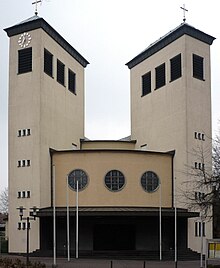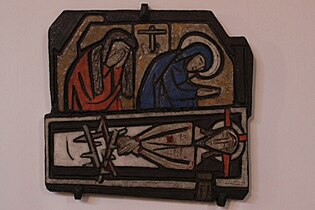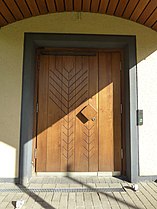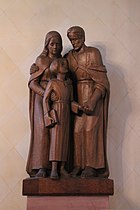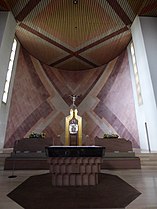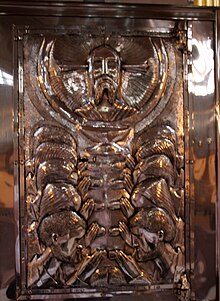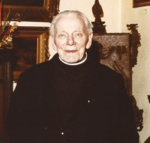St. Corpus Christi (Essen-Bochold)
The Church of St. Corpus Christi is a Roman Catholic church building in the Essen district of Bochold .
Building history of the church
First planned St. Corpus Christi Church
In 1907 the St.-Johannes-Kirchbauverein was founded to build a church for the rectorate parish of St. Corpus Christi. In 1914 the groundbreaking ceremony for the sacred building designed by the Düsseldorf architect Süldenfuß took place. However, with the beginning of World War I and the associated economic decline, all activities came to a standstill.
The "Dömchen" 1919
As a result of the poor financial situation, the community built an emergency church out of three former Krupp barracks, which they inaugurated on September 7, 1919 with a solemn ceremony by the dean and canon of honor Euskirchen.
On the occasion of this solemnity, this hymn to the new church was composed after the melody of the Germany anthem:
|
Where the tall chimneys smoke wherever the food fire glows. Where the miner in the earth digs the black diamond. Where fresh hands are moving warm the blood flows to the heart. : There is our home soil, who provides us with maintenance .: |
But with hard work struggles faith still lives unbowed. What so nice the new church testifies to us here in Bochold. See the people in great flocks rush to the church. : Praying for the highest goods in the times of storm: |
The calloused hands are also hard, the heart stayed feeling warm. Everyone likes to give his gift helps the need with a strong arm. Everyone is held by a ribbon real love and unity. : Is it important to achieve great things the ranks are ready: |
It should stay that way forever May God give us salvation. At work and praying always wave blessings. Faithful to the church, faithful, strong against false lying spirit. : That is our banner sign, which promises victory and reward: |
Works of art in the first church
Wooden statue of St. John the Baptist
The figure of St. John the Baptist stood until 1931, eaten by worms, as a frightening child in a hidden corner in St. Dionysius. Rector Bollig was able to get it from the mother parish and had it restored by Heinz Hasenäcker. Today it is in the entrance area of the new church, near the baptismal font.
Oil painting of St. Elisabeth
The oil painting now hangs over the entrance to the crypt.
In 1931, on the occasion of the 700th anniversary (1231–1931), Rector Bollig donated an altarpiece to St. Elisabeth , the middle section of which shows the saint with her three children at the fountain in front of the Wartburg and represents benefits to the needy and sick. This picture was created by the Düsseldorf painter Josef Hansen.
After the inflation began to collect for a new church building.
In 1932, the so-called Dömchen had become so unusable that a new building was inevitable.
Today's Church of St. Corpus Christi
Planning began in 1925 with the participation of the Essen architect Ludwig Becker. Cardinal Testa donated 400 gold marks as a foundation for the new church. In 1923 and 1924 he worked as an Apostolic Visitator in the Ruhr and Saar region . On April 17, 1932, the first cut of the spade for the first St. Corpus Christi Church in the Archdiocese of Cologne took place in accordance with church tradition by the then dean Gatzweiler von St. Josef from Essen- Frintrop . He was followed by the greatest patron of this church, Pastor Hubert Bollig. The plan for this church came from the architect and government master builder Alfred Ludwig Wahl from Essen, who also won the competition for the Klemens Maria Hofbauer Church in Altendorf .
The foundation stone was laid in June 1932. At the end of 1932 the church was consecrated by Auxiliary Bishop Joseph Hammels . The church was severely damaged during the Second World War in 1943 and gradually rebuilt until 1962. Structural changes followed in 1973 and 1992. On October 12, 1995 the church was listed as a historical monument.
architecture
On the architecture of St. Corpus Christi, Fredmann wrote in 1932:
“The new church is a very remarkable building. The title of St. Corpus Christi determines form and space. The pair of towers proclaim the character of this building creation from afar. As you approach, you discover the inclination of both towers; who strive for a central point inside the building. "
“You won't find anything comparable in this perfection. The entire tree motif looks a little strange at first or at least very original. The two towers have a very welcoming gesture. Through the main door you can always see the eternal light in a ruby red bowl. The interior surprises with its size and tranquility. The sidewalks bring variety and avoid monotony. "
“There are various reasons why this room looks so devout and harmonious. One reason is the high level of sidelight, the regular intervals between the supports, the calm wall surfaces and the shape of the ceiling. The decisive factor is the choir, which hugs the visitors and pulls them forward. You have a good view of the altar from all places. The title of the church did not make it possible to design a rectangular building. Out of the mystery of the Eucharist, the congregation has achieved this contemporary and yet timeless great achievement. "
“It will forever remain a glory in the history of the consistently poor community that they even managed to build such a building in these bad times. Some modern churches have been praised to heaven by art writers. Many of them are already ruins and documents of creative inadequacy and structural ineptitude. This fate will not overtake the Corpus Christi Church, as it was built with great technical skill. "
Bells
In the left church tower there are three bells that were consecrated on December 4, 1977 by Auxiliary Bishop Julius Angerhausen . On the holy night they rang for the first time for the service. These bells cost 40,000 DM and were financed through parish festivals and donations. The bell was cast at the Johannes Mark company in Brockscheid / Eifel on November 25, 1977. A delegation of 40 parishioners with Pastor Ulrich followed this event on site.
Description of the bells:
- Big bell - Corpus Christi bell (tone e); Presentation: Jesus Christ with the disciples of Emmaus; Inscription: "We are one body in Christ"
- Middle bell - Marienglocke (tone g); Presentation: Golden Madonna of Essen, mother of good advice; Inscription: "Everything that he tells you do!"
- Small bell - Joseph's bell (tone a); Presentation: image of St. Joseph; Inscription: "All in honor of my God"
St. Christopher
On June 25, 1944 Pastor Bollig wrote after the heavy air raids:
"St. Christophorus, the helper in need, is enthroned on the sacrament tower, steadfast against all storms in golden armor, wearing our Corpus Christi, seeing for all who look up and look out. "
Interior views
- Image selection from the Way of the Cross
- crypt
Works of art
altar
Through the redesign of the church by the Bochum architect Klemens Link, the choir with the altar became the center of the church again. The new altar was consecrated on November 28, 1992 by Bishop Luthe. It is made of red Main sandstone and carries the table top of the former high altar.
Holy Family
The Holy Family is a work of art by the Düsseldorf artist Edwin Hörner and was donated to the community by him on May 31, 1936. Immediately after school he had to go to war and when he returned his parents and siblings had perished. In this work he expresses the importance of the protective family and thereby set a monument to his lost family.
“With its monumentality and heavy natural wood color, the group looks particularly good thanks to the noble triad between father, mother and child. The own and unique scene of the rediscovery in the temple combines love and suffering, joy and concern into a harmonious whole. The feelings of mother and father, the hard and level-headed features in the workman's face of Joseph, unite around the lost and rediscovered Child of God, who transfigured and self-confident whether his mission stands before his parents like a light, his face raised to the question: “Did you know? not that I had to be in what my father is? ”Being happy and transfigured wants to resolve worries, wants to go with them, wants to help the worried parents' hearts. His lovingly opened heart, on which the mother's guarding hand lies, points to the great mission of his redemption for the entire human family. The boy's inspired right hand holds the book of books. He carries the truth into the world. But the left hand rests trustingly in the sorrowful callused hand of the father, as if he wanted to say? Don't worry, i'll stay with you. Deep, worried seriousness lies on the trains, as it were the shadow of the word: Your father was looking for you with pain. Joseph is aware of his responsibility, of his mission. He holds the boy, the happiness entrusted to him, while at the same time he reverently protects the virgin-maternal woman with his right hand. "
Baptismal font
The baptismal font was made from Danube limestone. Its inscription reads: “Go in peace and the Lord be with you.” On June 15, 1933, Pastor Bollig inaugurated the new baptismal font. It was financed by children's collections from school classes and by private donations.
Tabernacle door
Alfred Claßen, goldsmith from Essen and artist from the Folkwang School , drove the Lord's Supper in silver based on a design by Joseph Rademacher from Essen and attached it to the tabernacle as a border. The Lord's Supper scene is shown in an interesting and very clever solution. The treatment of the material (silver) proves a highly advanced technical skill, the intimate expression on the clearly grouped faces of the apostles testifies to a deeply inclined design art of the creators of the work.
The silver was brought up by parishioners through the collection of scrap silver.
Way of the Cross
The Way of the Cross was completed after five months of work by the local artist Grete Gömmer in the summer of 1975. It was financed by a donor who did not want to be named.
Family monstrance
The student of Josef Derix, Arts and Crafts in Kevelaer , Thone Pritzker, created this monstrance in 1934.
“The monstrance should keep the name, because there is no one more suitable for it. Their symbolism also makes them a family monstrance. There, Mary and Joseph, the holy parents, kneel in the middle on both sides of the capsule that holds the host. They kneel in front of the Child of Bethlehem, who is the center of the monstrance in the consecrated host and for whom the capsule - called Lunula in the liturgical language - serves as a cradle. Above the capsule, the cross indicates the sufferings that will be bestowed on the child of Bethlehem. The group is framed by an even triangle, the symbol for the Most Holy Trinity, which in itself is also a family, the highest and holiest family and at the same time the origin of all families. The new choirs of angels are grouped around the sign of the Most Holy Trinity, who surround the Child of Bethlehem and who worship and worship the Triune God. The overall symbolic representation, however, is surrounded by a golden circlet, which symbolizes the eternal God, the origin and sustainer of all life and whose goodness gave us the Redeemer in the Child of Bethlehem. From the syringe of the triangle swings the star that led the Three Wise Men to the Child of Bethlehem and is said to be a guide to this child for all of humanity. Gems and cameos are set in the foot of the monstrance. Each of these stones is a treasure in itself, not only as a work of art, but also in terms of its age and origin. "
Pietà
At the 11th International Exhibition of Christian Art in Rome in 1934, the Pietà by Franz Guntermann , the life-size work of art made of limewood, was exhibited.
After the exhibition in Rome, this Pietà was exhibited in Munich, Freiburg, Karlsruhe, Stuttgart, Frankfurt, Cologne and Bochum, among others, before it came to the Church of St. Corpus Christi.
Press reviews:
- Münchner Abendblatt of November 20, 1934: Guntermann's mother of sorrows impresses with the seriousness and strength of her religious feelings.
- Kieler Zeitung of November 25, 1934: [...] a sublime symbol for the mourning of the millions for their dead.
- L'illustratione Vaticana of March 16, 1934: [...] a Mater Dolorosa, completely enclosed in her pain, also closed to the outside by the serious garment with the broad, heavy surfaces; an interesting and poignant wooden sculpture.
crypt
After a renovation, the crypt was consecrated on April 2, 1991 by Dean Otmar Vieth. With 50 seats, it offers space for school services and weekday masses. The colorful ceiling painting and the wall design convey an inviting prayer atmosphere. Due to the semicircular seating arrangement of the benches, all worshipers are gathered closer around the altar. This creates a dense community of prayer.
List of pastors
Pastor
- Parish Rector Ernst Schmitz (1919–1930), born January 14, 1880, † September 10, 1969
- Parish Rector and Pastor Hubert Bollig (1930–1945)
- Pastor Ernst Temmesfeld (1945–1970), * July 8, 1900, † October 8, 1979
- Pastor Helmut Ulrich (1970–1985) * March 4, 1926, † July 27, 1985
- Pastor Johannes Kronenberg (1985-2000)
- Pastor Grave (2000–2002)
- Pastor Volker Bauer (2002–2008)
In 2008 the parish of St. Corpus Christi becomes part of the parish of St. Dionysius.
- Pastor Dr. Jürgen Cleve (2008-2018)
- Pastor Benedikt Ogrodowczyk (since 2018)
Pastors responsible for St. Corpus Christi
- Pastor Volker Bauer (2008-2018)
Chaplains
- Kaplan Ostermann (until 1953)
- Kaplan Kuhleweg (1953–1959)
- Chaplain Göbel (1959-1965)
- Chaplain Otten (1965–1970)
- Kaplan Schmitt (1970–1975)
- Chaplain Wilmsen (1975–1980)
- Chaplain Georg Haffki (1980–1985)
- Chaplain Michael Fey (1985-1989)
- Chaplain Burkhard Jehl (1989–1993)
- Chaplain Gary Albrecht (1993–1994)
- Chaplain Bernd Wolharn (1995–2000)
Pastors
- Pastoral assistant Antonie Vedder (1955–1970)
- Community advisor Ms. Cornelius (2001–2002)
- Community officer Cornelia Biermann (from 2002, from 2016 with coordination tasks)
Web links
Individual evidence
- ↑ From the original program of the festive event
- ↑ a b Heinz Dohmen; Eckhard Sons: Churches, chapels, synagogues in Essen . Ed .: Norbert Beleke . Nobel, Essen 1998, ISBN 3-922785-52-2 .
- ↑ Excerpt from the list of monuments of the city of Essen ; accessed on September 14, 2017
- ↑ Chronicle of the parish
Coordinates: 51 ° 27 ′ 58.4 " N , 6 ° 57 ′ 27.7" E
